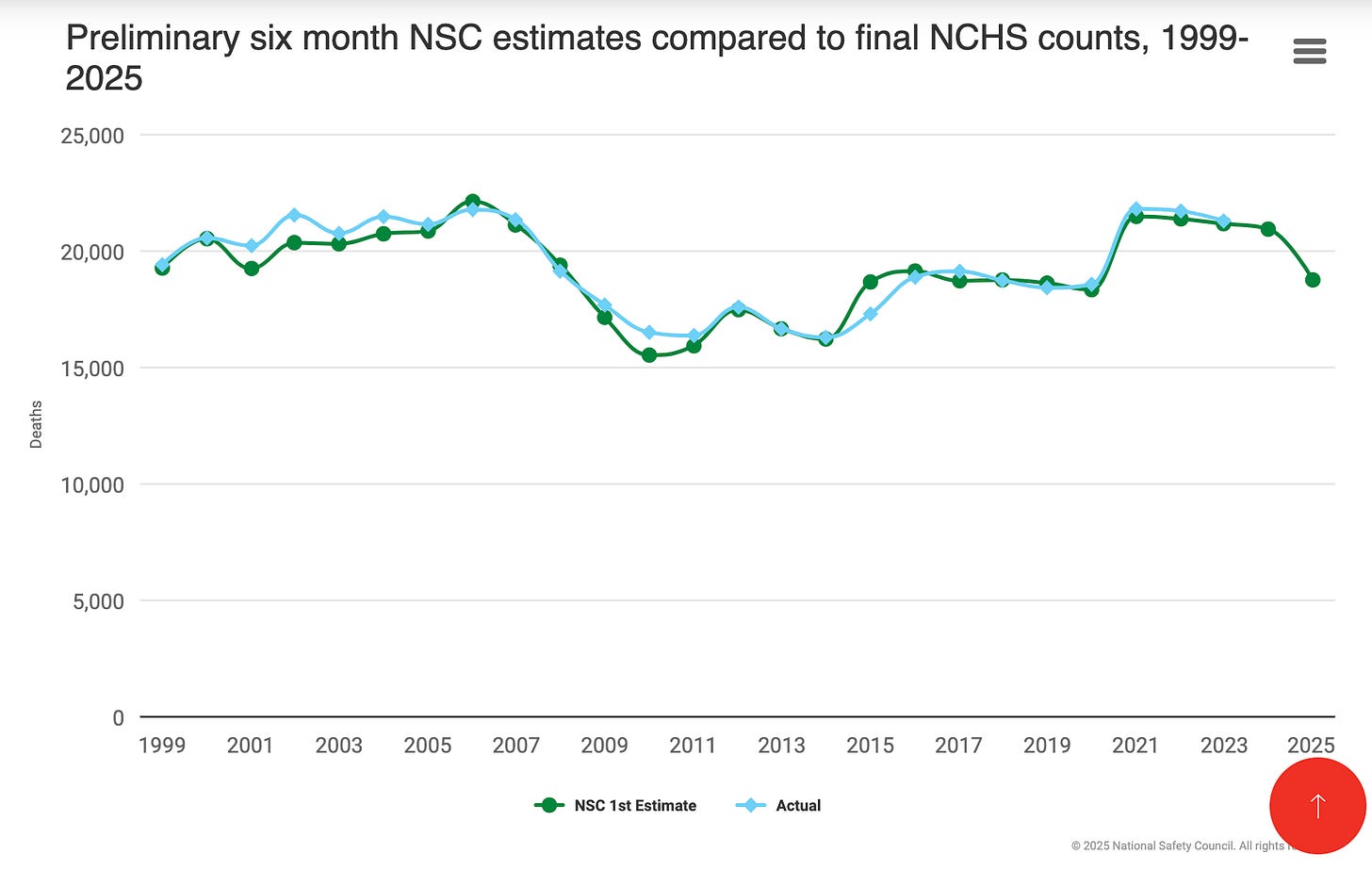Some Good News: Traffic Fatalities Down 13.5% This Year
More evidence that the George Floyd Racial Reckoning is over and done with.
In this century, homicide and traffic fatality trends have been somewhat correlated, typically with motor vehicle deaths lagging a little behind homicide victimizations. Both fell during the 2008 Great Recession, then rose during the Ferguson Effect, then shot upward during the Floyd Effect.
Now, there is good news that 2025 has started off well for both homicides and road deaths. The National Safety Council estimates:
Traffic crashes claimed 13% fewer lives in the first half of 2025 compared to the same period last year, preliminary analysis by the National Safety Council shows. An estimated 18,720 people died in traffic crashes from January to June, even as Americans drove 0.8% more miles.
“This decrease in traffic deaths represents tremendous progress and shows what's possible when states and communities commit to proven safety strategies," said Mark Chung, executive vice president of safety leadership and advocacy at NSC. "We're seeing the results of states and localities implementing the Safe System Approach – focusing on safer roads, safer speeds, safer vehicles, safer people and better post-crash care. This success demonstrates that when we work together using evidence-based solutions, we can save lives and make all road users safer.”
The results varied widely across states. Ten states and the District of Columbia achieved decreases of 20% or more: District of Columbia led with a -67% reduction, followed by California (-43%), Connecticut (-34%), Mississippi (-34%), Alaska (-31%), Delaware (-25%), Alabama (-21%), Kentucky (-21%), Vermont (-21%), Maryland (-20%) and Minnesota (-20%).
Four states, however, saw increases of 20% or more in traffic crash deaths: Hawaii (+46%), Oklahoma (+32%), Kansas (+30%) and West Virginia (+21%).
The rate dropped to 1.15 deaths per 100 million vehicle miles traveled – a 13.5% decrease from 2024 and 2023.
Here’s the NSC’s graph. The green line is their preliminary estimate and the blue line represents the final count according to the CDC mortality stats (which come with a six month lag for motor vehicle accidents). In other words, most years their estimates are pretty accurate.
Car thefts dropped in 2024. From the National Insurance Crime Bureau in March 2025:
Vehicle Thefts in United States Fell 17% in 2024
2024 Vehicle Theft Trends - The most stolen vehicles in the United States
Largest Decrease in Stolen Vehicles in Last 40 Years
OAK BROOK, IL, March 18, 2025 – After four years of surging vehicle thefts, the number of stolen vehicles in the United States fell to pre-pandemic levels in 2024. Thefts nationwide decreased 17% from 2023 to 2024, dropping below the one million mark for the first time since 2021 and marking the largest annual decrease in stolen vehicles in the last 40 years, according to the National Insurance Crime Bureau (NICB), the nation’s leading not-for-profit organization exclusively dedicated to identifying, investigating, preventing, and deterring insurance fraud and crime.
Car thefts took off in 2020. Then, somebody posted a video on Tik-Tok in July 2022 showing how to hotwire a Kia or Hyundai, which led to a surge in thefts of those two brands. (The dealers will now add immobilizers for free.)
If these trends keep up, we might finally get some relief from automobile insurance inflation.
From Yahoo Finance in August 2025:
But the biggest jump has been in the cost of insurance, up 60% during the last five years, to an average monthly premium of about $213. A bill that was once an afterthought now totals nearly $3,000 per year, and a lot more for some vehicles and drivers.
Relief is on the horizon. In April 2024, the annual rate of car insurance inflation peaked at 23%. It’s now at a much tamer 5.3%, and the lower annual price hikes are likely to stick.
In 2025, data shows insurers are raising premiums by about 7.5%, significantly lower than the 16.5% increase in 2024 and 12% in 2023.
Yeah, well, 7.5% inflation is nothing to write home about, but it’s better than 16.5% auto insurance inflation in 2024.



So, not only are deaths of exhuberance down, but thefts of exhuberance are down as well. Now if we can just get the trannies in line...
Is 40,000 a good estimate of the absolute number of traffic-fatality excess-deaths, mid-2020 thru late(?)-2024?
For scale-comparison: 220,000 to 225,000 is equal to one-tenth of a TFR-point (0.1 TFR) in the early 2020s I.e., say TFR dropped from 1.500 to 1.400 between two adjacent years: Pegged to early-mid 2020s cohort-demographics in the USA, all races, that -0.1 TFR-point drop would mean an absolute-reduction in about 225,000 "babies not born."
Although it takes a long time for this particular "bill to come due," fluctuations of several-tenths of a TFR-point over 4.5 years have been enough for a reduction of several million babies not born.
The birth-rate drop associated with the early 2020s is 100x greater than the traffic-fatality excess-deaths of the same period (several million babies not born vs. apparently 40,000 extra traffic-deaths).